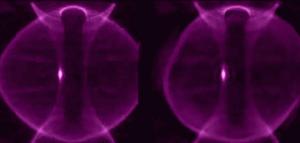The jellyfish that got trapped in a fusion machine
19 Oct 2015
-
Culham Centre for Fusion Energy
The technique used in the video clip lets fusion researchers view phenomena that cause the plasma's edge to wobble but are not visible with the naked eye—potentially very useful in detecting "unseen" plasma instabilities that reduce the confinement of energy in a tokamak.
It looks like a jellyfish is trapped inside of a fusion machine. But nature lovers can relax: the video at right is a real—if unusual—record of a plasma experiment inside the spherical MAST tokamak at the Culham Centre for Fusion Energy (CCFE).
In the image on the right side, a MAST plasma is processed with a magnification method called Eulerian Video Magnification. (At left, a normal MAST plasma without the processing applied, for comparison.)
This technique takes a static image, detects small changes in intensity of the light (such as small movements in the images) and amplifies them. It is well suited to footage of tokamak plasmas and has already been used to good effect on MAST.
The "jellyfish" plasma in this clip, produced by CCFE's Thomas O'Gorman, lets fusion researchers view phenomena (a 2,1 tearing mode in this case) which cause the plasma's edge to wobble but are not visible with the naked eye. This is potentially very useful in detecting "unseen" plasma instabilities that reduce the confinement of energy in a tokamak.
So, if you'll pardon the pun, the much-maligned jellyfish could help take the "sting" out of plasma instabilities and propel fusion towards the electricity grid...


